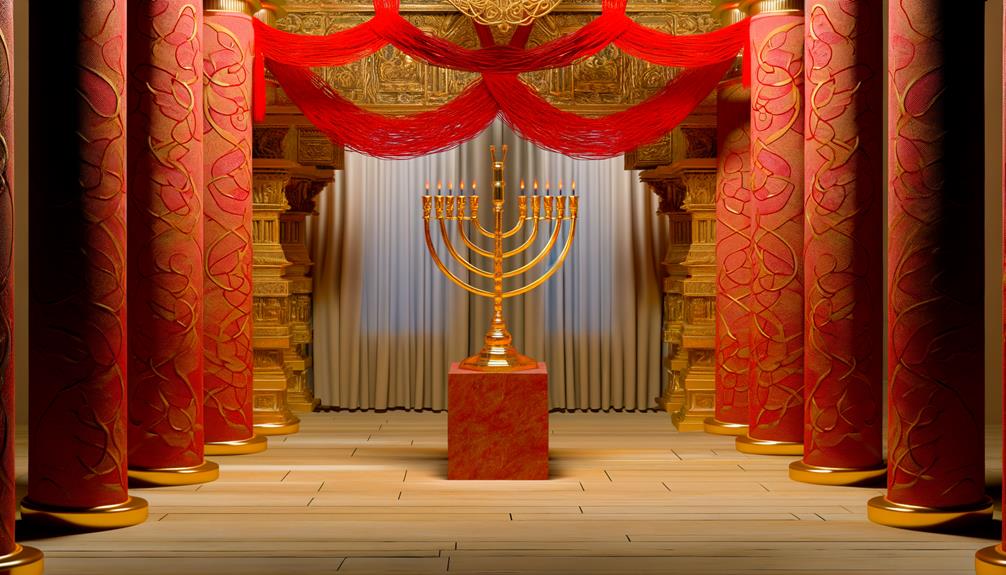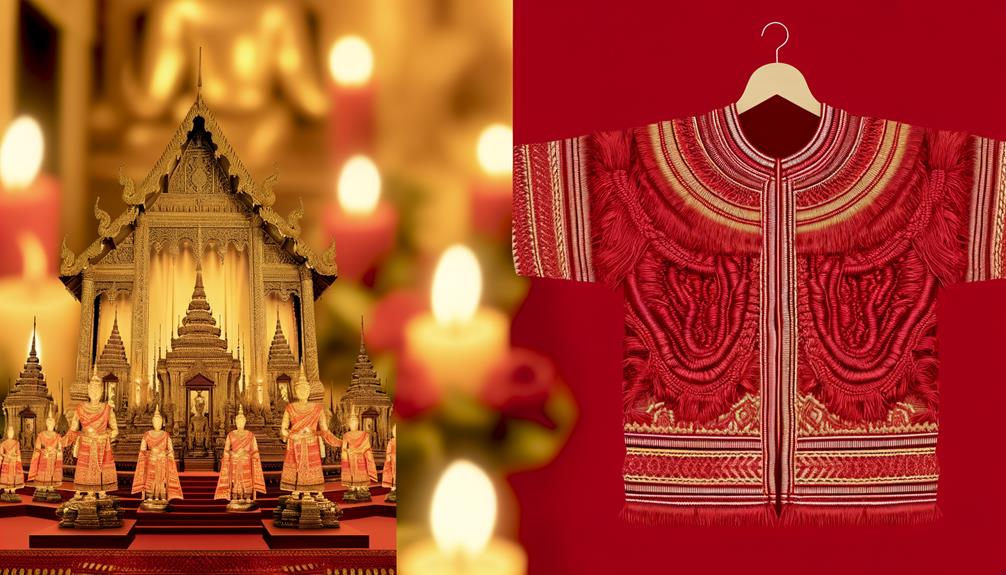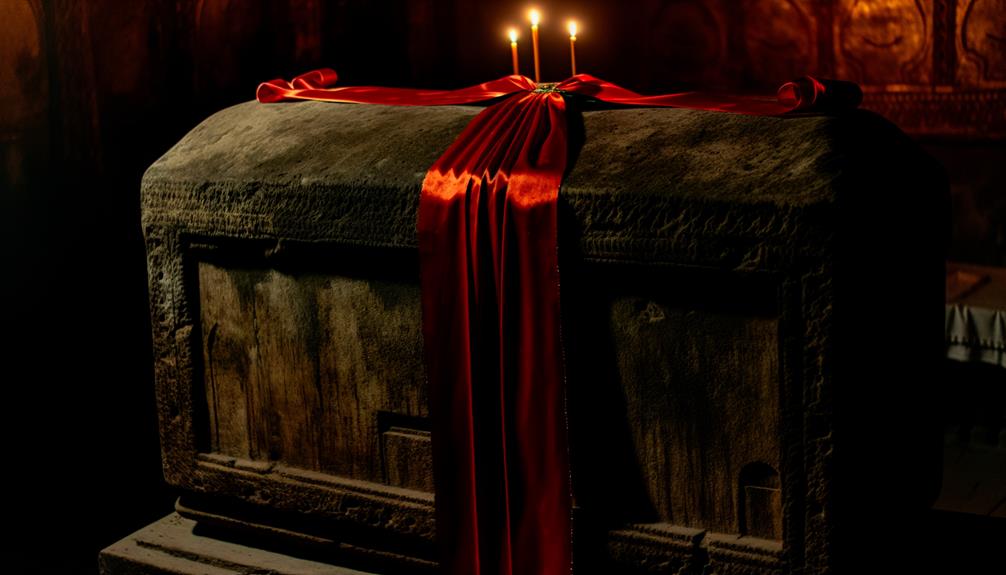Red Ribbon Meaning in the Bible: Covenant and Protection
In biblical literature, the red ribbon, frequently manifested as a scarlet cord, symbolizes profound themes of covenant, redemption, and divine protection. Significantly, Rahab’s scarlet cord in the Book of Joshua signifies her faith and guarantees her family’s safety, exemplifying God’s inclusive salvation.
This red thread extends to the broader tapestry of biblical symbolism, underscoring rituals and covenants such as the Passover lamb’s blood. Such symbols reinforce the continuity of divine promises and foreshadow Christ’s ultimate sacrifice.
Further exploration of red ribbon symbolism in biblical contexts reveals the intricate layers of religious metaphor and theological depth.

Biblical Meaning of a Red Ribbon: Protection, Salvation, and Covenant
| Interpretation | Meaning | Explanation |
|---|---|---|
| Protection and Salvation | Symbolizes protection and salvation through blood. | In Joshua 2:18, Rahab ties a scarlet (red) cord in her window as a sign to protect her household during the fall of Jericho. The red ribbon symbolizes protection through obedience and faith. |
| Blood and Atonement | Represents the sacrifice of blood for atonement. | The color red often signifies blood, which is crucial for atonement and forgiveness of sins, as seen in Hebrews 9:22—”without the shedding of blood there is no forgiveness.” |
| Covenant and Promise | Reflects God’s promise of salvation and covenant with His people. | The scarlet cord in Rahab’s story also represents the fulfillment of a promise to protect her family, symbolizing the red ribbon as a sign of God’s faithfulness and covenant. |
| Spiritual Protection | Serves as a reminder of spiritual protection and deliverance. | Like the blood on the doorposts during Passover (Exodus 12:7), a red ribbon can symbolize divine protection from danger and evil. |
Rahab and the Scarlet Cord

The story of Rahab and the scarlet cord, found in the Book of Joshua, serves as a profound biblical symbol of faith and deliverance.
Rahab, a Canaanite prostitute, shelters Israelite spies in Jericho, recognizing their God’s sovereignty. Her faith leads her to negotiate a pact for her family’s safety, symbolized by a scarlet cord hanging from her window.
This act of faith not only secures her family’s survival but also integrates her into the lineage of Israel, highlighting the inclusive nature of God’s covenant.
The scarlet cord becomes a tangible sign of her faith and the Israelites’ divine mission, emphasizing the theological significance of obedience and trust in divine promises within the narrative structure of the Old Scriptures.
Symbolism of Redemption

The symbolism of redemption inherent in the red ribbon is deeply rooted in the theological framework of the Blood Covenant, which signifies God’s unwavering promises and commitments to His people.
This concept finds its ultimate fulfillment in the New Testament, where Christ’s sacrificial blood epitomizes the ultimate act of redemption for humanity.
Consequently, the red ribbon serves as a vivid representation of both historical covenants and the redemptive power of Christ’s atonement.
Blood Covenant Significance
In biblical theology, the concept of the blood covenant is profoundly significant as it symbolizes redemption and the unbreakable bond between God and humanity. This covenant manifests pivotal theological principles, reflecting divine commitments and human responsibilities.
The red ribbon, as a symbol of this covenant, evokes powerful imagery:
- Sacrificial altars where offerings were made to atone for sins.
- Passover lambs whose blood marked the homes of the faithful during the Exodus.
- Scarlet threads tied around the wrists in ancient Hebrew rituals.
- Blood-sprinkled mercy seats within the Holy of Holies.
Each instance underscores the profound connection and redemption that the blood covenant represents, affirming God’s unwavering promise to His people.
Christ’s Sacrificial Blood
Christ’s sacrificial blood, epitomized by the red ribbon, serves as the ultimate symbol of redemption and the fulfillment of the Old Covenant.
Theologically, this signifies the shift from the sacrificial system of the Old Testament to the singular, efficacious sacrifice of Christ.
The red ribbon, reminiscent of the blood of the Passover lamb, underscores the deliverance from sin and eternal death.
In Hebrews 9:12, it is asserted that Christ entered the Most Holy Place ‘by his own blood, thereby securing eternal redemption.’
This act not only consummates the prophetic promises but also inaugurates the New Covenant.
Symbolically, the red ribbon thereby bridges the continuity of God’s salvific plan from the Old Testament through Christ’s atoning sacrifice.
Protection and Salvation

A prominent interpretation of the red ribbon in biblical texts suggests it serves as a symbol of divine protection and salvation. This interpretation is deeply rooted in various scriptural accounts where the red ribbon or scarlet thread is depicted as a divine marker.
- Joshua 2:18: Rahab uses a scarlet cord to guarantee her household’s safety during Jericho’s conquest.
- Exodus 12:7: Blood on the doorposts marks the Israelites’ homes, protecting them from the plague.
- Genesis 38:28: A scarlet thread on Zerah’s wrist signifies identification and preservation within his lineage.
- Hebrews 9:19: The sprinkling of blood, symbolizing purification and sanctification.
These instances collectively emphasize the red ribbon’s theological significance in the context of protection and salvation.
Covenant and Promise

In biblical scholarship, the red ribbon frequently emerges as a potent symbol of covenant and promise, signifying the establishment of a binding agreement and divine assurance between God and His people.
This thematic element is evident in various scriptural narratives, where the red ribbon functions as a tangible representation of God’s unwavering commitment and the reciprocal obligations of the covenant.
Such symbolism underscores the theological importance of divine fidelity and the human response in the biblical tradition.
Symbol of Agreement
Throughout biblical texts, the red ribbon frequently serves as a potent symbol of covenant and promise, signifying divine agreements and human commitments. These sacred agreements are often marked by vivid imagery and poignant symbolism. Theologically, the red ribbon encapsulates the essence of binding promises and divine covenants, resonating deeply within scriptural narratives.
- The scarlet cord of Rahab, symbolizing her agreement with the Israelite spies.
- The crimson thread in the story of Tamar and Judah, indicating a lineage covenant.
- The red thread in the Tabernacle, representing God’s dwelling among His people.
- The cord in the binding of Isaac, symbolizing Abraham’s covenant with God.
Each instance underscores the profound significance of divine and human pacts.
Divine Assurance
The red ribbon, beyond symbolizing agreement, fundamentally embodies the concept of divine assurance, encapsulating God’s unwavering promises and covenants with humanity.
This symbol serves as a tangible reminder of the divine fidelity and commitment that underpin biblical narratives. For instance, in Joshua 2:18, the scarlet cord signifies Rahab’s assurance of protection, demonstrating a physical manifestation of God’s covenant.
Theologically, this red ribbon can be seen as an emblem of divine providence and unbreakable promises, echoing the steadfastness of God’s word. Such symbols reinforce the believer’s faith in God’s enduring promises, acting as a visual representation to the divine assurances that permeate scripture.
This interpretative lens enriches our understanding of the red ribbon’s deeper biblical significance.
Threads in the Tabernacle

Examining the intricate threads in the Tabernacle reveals deep theological symbolism that underscores the sanctity and divine craftsmanship of this sacred space. Each thread represents a facet of divine revelation and human response to God’s covenant. The biblical text meticulously describes the materials and colors used, reflecting the multifaceted nature of divine holiness.
- Gold threads: symbolizing divine purity and kingship.
- Blue threads: denoting heavenly origin and divine law.
- Purple threads: representing royalty and sovereignty.
- Scarlet threads: signifying sacrifice and redemption.
This meticulous weaving not only enhances the aesthetic beauty of the Tabernacle but also serves as a constant reminder of Israel’s relationship with the Divine, encapsulating theological truths within its very fabric.
Scarlet Yarn in Priest Garments

Building upon the symbolic significance of the Tabernacle’s threads, the scarlet yarn in priestly garments holds profound theological implications, particularly in its association with atonement and sanctification.
Within the Old Scripture, specifically in Exodus 28:5-6, the inclusion of scarlet yarn in the ephod of the High Priest symbolizes the purification and consecration necessary for approaching the divine presence.
This color, rich in biblical symbolism, underscores the gravity of the priestly role in mediating between God and the Israelites.
The scarlet yarn, interwoven with gold, blue, and purple threads, manifests a visual theology of redemption and holiness, indicating the priest’s unique consecration and the requisite purity for their sacred duties.
Blood Sacrifice Connection

Integral to understanding the red ribbon’s biblical symbolism is its profound connection to the concept of blood sacrifice, which embodies themes of atonement and divine covenant. The Biblical narrative is rich with instances where blood serves as a critical element in sanctifying and purifying the chosen people.
The red ribbon, in its scarlet hue, evokes powerful imagery tied to sacrificial rites, underscoring the theological significance of Christ’s ultimate sacrifice.
- Passover Lamb’s blood on doorposts: Protection and divine favor.
- Covenant of Circumcision: Symbol of belonging and commitment.
- Temple sacrifices: Atonement for sins through animal offerings.
- Scarlet cord of Rahab: Preservation and divine promise.
These elements collectively enhance our understanding of the red ribbon’s symbolic depth.
Red Ribbon in Christian Tradition

Within Christian tradition, the red ribbon has come to symbolize not only the sacrificial blood of Christ but also the enduring themes of redemption, protection, and divine grace.
Theologically, the red ribbon mirrors the Passover narrative, where the blood of the lamb protected the Israelites. This emblematic use underscores salvation through Christ’s atoning sacrifice.
Additionally, the red ribbon is often linked to the concept of divine grace, suggesting that believers are enveloped in God’s love and forgiveness.
In various Christian practices, the red ribbon serves as a tangible reminder of these profound spiritual truths, reinforcing the covenant relationship between God and humanity.
Consequently, it remains a potent symbol in liturgical settings and devotional observances.
Modern Interpretations

In contemporary theological discourse, the red ribbon is often reinterpreted to address modern spiritual and social issues, serving as a versatile symbol that bridges ancient scriptural themes with present-day contexts.
Its multifaceted symbolism can be observed in various applications, making it a powerful tool for contemporary reflection and advocacy.
- Advocacy Against Injustice: Representing a call to action against societal wrongs.
- Health Awareness: Symbolizing the fight against diseases like HIV/AIDS.
- Unity and Solidarity: Emphasizing communal bonds and collective resilience.
- Spiritual Renewal: Signifying personal transformation and redemption.
These modern interpretations underscore the enduring relevance of the red ribbon, illustrating its capacity to inspire and mobilize across diverse contexts.
Conclusion
The red ribbon in biblical text emerges as a profound symbol of redemption, protection, and divine covenant. In the Old Testament, the red ribbon is often associated with the blood of sacrifices and the Passover lamb, which is a powerful symbol of redemption and atonement. This imagery is further emphasized in the New Testament, where the blood of Jesus is seen as the ultimate sacrifice for the redemption of humanity. Additionally, the red door symbolism in biblical texts represents the protection of homes from the plague and the establishment of a divine covenant with God. These symbols serve as reminders of God’s faithfulness and mercy throughout history.
Woven through narratives such as Rahab’s scarlet cord and the sacred threads in priestly garments, it signifies the blood sacrifice fundamental to salvation.
This emblematic color threads together themes of atonement, divine promise, and spiritual deliverance, illustrating the theological depth and enduring symbolism within Christian tradition.
Consequently, the red ribbon is a vivid representation of the enduring covenant between the divine and humanity.






